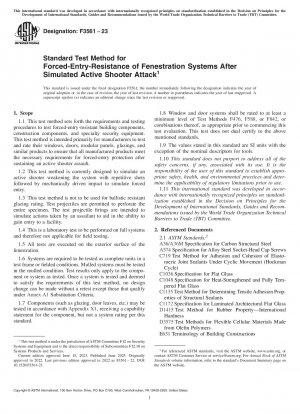ASTM F3561-23
Standard Test Method for Forced-Entry-Resistance of Fenestration Systems After Simulated Active Shooter Attack
- Standard No.
- ASTM F3561-23
- Release Date
- 2023
- Published By
- American Society for Testing and Materials (ASTM)
- Latest
- ASTM F3561-23
- Scope
- 1.1 This test method sets forth the requirements and testing procedures to test forced-entry-resistant building components, construction components, and specialty security equipment. This test method is intended primarily for manufacturers to test and rate their windows, doors, modular panels, glazings, and similar products to ensure that all manufactured products meet the necessary requirements for forced-entry protection after sustaining an active shooter assault. 1.2 This test method is currently designed to simulate an active shooter weakening the system with repetitive shots followed by mechanically driven impact to simulate forced entry. 1.3 This test method is not to be used for ballistic resistant glazing rating. Test projectiles are permitted to perforate the entire specimen. The test projectile firings are intended to simulate actions taken by an assailant to aid in the ability to gain entry to a facility. 1.4 This is a laboratory test to be performed on full systems and therefore not applicable for field testing. 1.5 All tests are executed on the exterior surface of the fenestration. 1.6 Systems are required to be tested as complete units in a test frame or fielded conditions. Mulled systems must be tested in the mulled condition. Test results only apply to the component or system as tested. Once a system is tested and deemed to satisfy the requirements of this test method, no design change can be made without a retest except those that qualify under Annex A1 Substitution Criteria. 1.7 Components (such as glazing, door leaves, etc.) may be tested in accordance with Appendix X1, receiving a capability statement for the component, but not a system rating per this standard. 1.8 Window and door systems shall be rated to at least a minimum level of Test Methods F476, F588, or F842, or combinations thereof, as appropriate prior to commencing this test evaluation. This test does not dual certify to the above mentioned standards. 1.9 The values stated in this standard are SI units with the exception of the nominal descriptors for tools. 1.10 This standard does not purport to address all of the safety concerns, if any, associated with its use. It is the responsibility of the user of this standard to establish appropriate safety, health, and environmental practices and determine the applicability of regulatory limitations prior to use. 1.11 This international standard was developed in accordance with internationally recognized principles on standardization established in the Decision on Principles for the Development of International Standards, Guides and Recommendations issued by the World Trade Organization Technical Barriers to Trade (TBT) Committee.
ASTM F3561-23 Referenced Document
- ASTM A36/A36M Standard Specification for Carbon Structural Steel
- ASTM A574 Standard Specification for Alloy Steel Socket-Head Cap Screws
- ASTM C1036 Standard Specification for Flat Glass
- ASTM C1048 Standard Specification for Heat-Treated Flat Glass--Kind HS, Kind FT Coated and Uncoated Glass
- ASTM C1135 Standard Test Method for Determining Tensile Adhesion Properties of Structural Sealants
- ASTM C1172 Standard Specification for Laminated Architectural Flat Glass
- ASTM C719 Standard Test Method for Adhesion and Cohesion of Elastomeric Joint Sealants Under Cyclic Movement (Hockman Cycle)
- ASTM D1415 Standard Test Method for Rubber Property—International Hardness
- ASTM D3575 Standard Test Methods for Flexible Cellular Materials Made From Olefin Polymers
- ASTM E631 Standard Terminology of Building Constructions
- ASTM F1915 Standard Test Methods for Glazing for Detention Facilities
- ASTM F476 Standard Test Methods for Security of Swinging Door Assemblies
- ASTM F588 Standard Test Methods for Measuring the Forced Entry Resistance of Window Assemblies, Excluding Glazing Impact
- ASTM F842 Standard Test Methods for Measuring the Forced Entry Resistance of Sliding Door Assemblies, Excluding Glazing Impact
ASTM F3561-23 history
- 2023 ASTM F3561-23 Standard Test Method for Forced-Entry-Resistance of Fenestration Systems After Simulated Active Shooter Attack
- 2022 ASTM F3561-22 Standard Test Method for Forced-Entry-Resistance of Fenestration Systems After Simulated Active Shooter Attack
